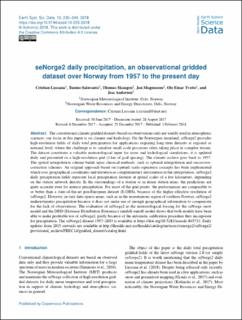| dc.description.abstract | The conventional climate gridded datasets based on observations only are widely used in atmospheric sciences; our focus in this paper is on climate and hydrology. On the Norwegian mainland, seNorge2 provides high-resolution fields of daily total precipitation for applications requiring long-term datasets at regional or national level, where the challenge is to simulate small-scale processes often taking place in complex terrain. The dataset constitutes a valuable meteorological input for snow and hydrological simulations; it is updated daily and presented on a high-resolution grid (1 km of grid spacing). The climate archive goes back to 1957. The spatial interpolation scheme builds upon classical methods, such as optimal interpolation and successive-correction schemes. An original approach based on (spatial) scale-separation concepts has been implemented which uses geographical coordinates and elevation as complementary information in the interpolation. seNorge2 daily precipitation fields represent local precipitation features at spatial scales of a few kilometers, depending on the station network density. In the surroundings of a station or in dense station areas, the predictions are quite accurate even for intense precipitation. For most of the grid points, the performances are comparable to or better than a state-of-the-art pan-European dataset (E-OBS), because of the higher effective resolution of seNorge2. However, in very data-sparse areas, such as in the mountainous region of southern Norway, seNorge2 underestimates precipitation because it does not make use of enough geographical information to compensate for the lack of observations. The evaluation of seNorge2 as the meteorological forcing for the seNorge snow model and the DDD (Distance Distribution Dynamics) rainfall–runoff model shows that both models have been able to make profitable use of seNorge2, partly because of the automatic calibration procedure they incorporate for precipitation. | en_US |
